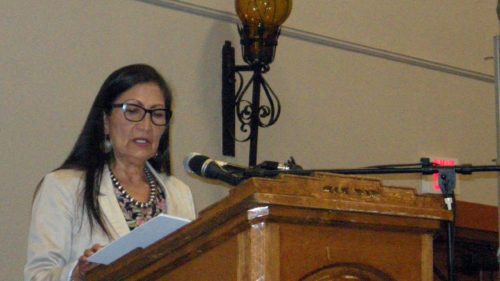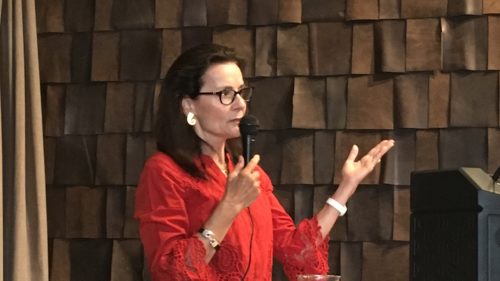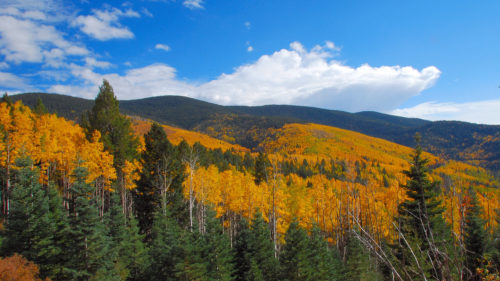By BEN NEARY
NMWF Conservation Director
In 2005, Joanna Prukop co-authored an article warning that coyote-killing contests threatened to tarnish the image of all hunting. It took the rest of New Mexico nearly 15 years to catch up with her.
In reaching the conclusion to oppose coyote-killing contests, Prukop relied on the North American Model — the philosophies, policies and laws that together guide wildlife conservation.
Prukop, the recently appointed chair of the New Mexico Game Commission, will speak about the North American Model and also take questions from the public about wildlife management issues as the August guest speaker in the New Mexico Wildlife Federation’s monthly lecture series.
Prukop’s free talk starts at 5:30 p.m., Wed., Aug. 14, at Marble Brewery’s Northeast Heights location at 9904 Montgomery Blvd., NE, in Albuquerque.
The New Mexico Legislature this year outlawed coyote-killing contests, events in which shooters compete for cash prizes for killing the most or the biggest coyotes. The New Mexico Wildlife Federation supported the ban on the grounds that such contests violate the North American Model.
“It got legislated because the Game and Fish Department did not get out in front of it,” Prukop said of this year’s ban. “Nor did the hunters and trappers of the state get out in front of it, recognizing that it’s detrimental to their own sport, which they care very much about.”
Before taking over as the first woman to chair the game commission, Prukop served as the secretary of the state Energy, Minerals and Natural Resources Department. Before that, she worked for 25 years at the New Mexico Department of Game and Fish. After leaving state government, she served in President Barack Obama’s administration as a three-term appointee to the Wildlife and Hunting Heritage Conservation Council. She holds a master’s degree in wildlife biology from Colorado State University.
The North American Model has seven general tenants:
1. Wildlife Resources Are a Public Trust;
2. Markets for Game Are Eliminated;
3. Allocation of Wildlife Is by Law;
4. Wildlife Can Be Killed Only for a Legitimate Purpose;
5. Wildlife Is Considered an International Resource;
6. Science Is the Proper Tool to Discharge Wildlife Policy;
7. Democracy of Hunting Is Standard.
Elements of those seven tenants go back to the teachings and observations of America’s greatest conservationists, people such as Teddy Roosevelt, George Bird Grinnell, and Aldo Leopold, the founder of the New Mexico Wildlife Federation.
But it wasn’t until recent decades that those teachings came together under the heading “North American Model,” largely under the scholarship of Canadian biologists Valerius Geist and Shane Mahoney.
Perhaps the easiest way to understand what the North American Model means in practice is to consider the difference between what it takes to go hunting or fishing in New Mexico, or elsewhere in North America, versus just about anyplace else in the world.
In New Mexico, for example, we can grab a rod and hit the Rio Grande anytime we want to go fishing on public land. We don’t ask permission because the water and the fish belong to the public. The only requirement is a fishing license.
But how about if you want to catch a fish in England? That’s bloody splendid, as long as you don’t forget your “cheque book.”
It’s a crime to fish a stretch of river in England for trout or salmon without written permission from whoever owns the “fishing rights.” Such rights, which may be owned separately from the surrounding property, are jealously guarded and broken down into closely patrolled segments often just a few hundred yards long. If you’re in the market, there are special brokers who can set you up to buy fishing rights, but be warned it will be a very pricey endeavor.
The concept that wildlife belongs to the public lies at the heart of the North American Model. But Prukop warns that our rights come with responsibilities. Hunters and anglers aren’t the only ones these days demanding to be heard on issues of wildlife management and hunters and anglers need to be conscious of how their activities are perceived by the larger public, Prukop said.
“As a commissioner I certainly understand that wildlife resources in our state are public trust resources, managed by a government entity for all citizens of the state,” Prukop said. “That’s one key point that people have to grasp is that these public trust resources belong to all the people whether you’re a consumptive user, a non consumptive user, or whether you’re not directly involved.”
Prukop said it’s important to maintain legitimate manners and methods of hunting in the future.
“I have concerns about the gadget world,” Prukop said. “I have concerns about we’re separating muzzleloaders from rifles and giving muzzleloaders an advantage when today’s muzzleloaders, especially in-lines with scopes and the bullets that they have now that sort of constitute an actual rifle bullet by the time they leave the barrel — is that actually primitive hunting anymore? In my early days with Game and Fish, people hunted elk with a .50-caliber Hawken, right?”
Prukop said she also would like to see the game commission address the difference between hunting and what she calls merely shooting.
“I believe in hunting not shooting,” Prukop said. “And having come from Texas, where I would say the majority of hunters practice shooting, you get what I’m saying? It’s over a feeder, or it’s down a sendero. It’s not like hunting in the Rocky Mountain West. I’m a proponent of fair chase and hunting. I’m kind of against gadgets, and that kind of thing.
“So as we talk about the North American Model, and what our citizens will see as legitimate, fair, and support as an activity, that’s an example of something I think we need to give a lot of thought,” she said.
Prukop says it’s important for hunters and anglers to understand what the model is about, what the different pieces of it are and how all of it affects their lives as they pursue their interests. Failure to be aware of the model, or to follow its precepts, puts the future of hunting and fishing in danger, she said.
“If everyone feels like they have a voice in wildlife management, their critters are being taken care of, and we’re being responsible about how we manage the animals we harvest, then I believe we’re all stronger for it. We’re all on much stronger ground for that,” Prukop said.
At her talk, Prukop said she plans to ask people for suggestions on how to make the model relevant in today’s world and going forward, and how it should relate to the state’s conservation agenda.
Prukop said she’s happy to take other questions about game management. She said she would welcome game department employees to hear what the public has to say.
“I’ll definitely be talking about modern day challenges to the precepts of the model,” Prukop said. “A big part of that are the social aspects of conservation today, and how that has changed over time. I’ll also be talking about the fact that the precepts of the model and ideas that people might take from those core ideas are actually not black and white, and why they’re gray.”



